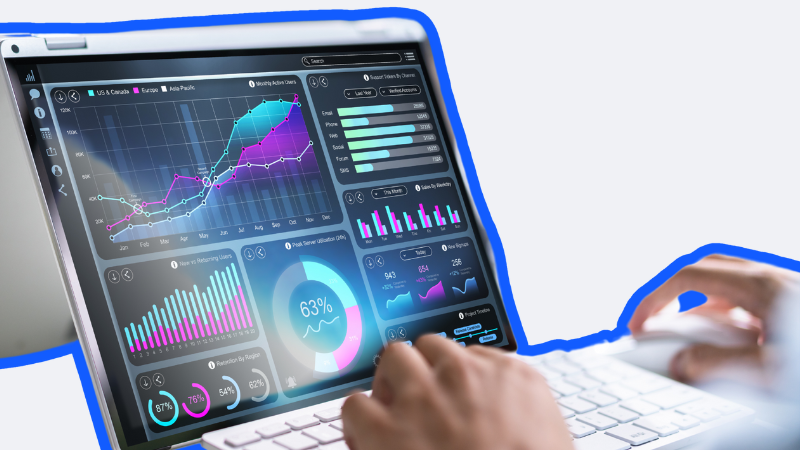The financial services industry is undergoing a major transformation, driven by digitalisation, evolving customer expectations, and heightened regulatory scrutiny. At the heart of this transformation is data science and analytics, which are reshaping how banks operate, manage risk, and deliver services. With global banking generating an estimated 2.5 quintillion bytes of data daily, institutions that effectively harness this information gain a significant competitive edge.
In this post, we explore the critical role of data science and analytics in modern banking, the key applications shaping the industry, and how financial institutions can stay ahead in a data-driven world.
The Growing Role of Data Science in Banking
Data science combines statistical modelling, machine learning, and artificial intelligence (AI) to analyse large volumes of structured and unstructured data. In banking, its applications span risk management, fraud prevention, customer insights, and operational efficiency.
According to a report by McKinsey & Company, banks that successfully integrate data-driven decision-making can increase profits by up to 15% and improve customer retention by 10-20%. The growing reliance on data-driven strategies highlights the necessity of investing in analytics and AI capabilities.
Key Areas Where Data Science Is Transforming Banking
1. Risk Management and Fraud Detection
Financial fraud is a multi-trillion-dollar global issue. According to PwC's 2024 Global Economic Crime and Fraud Survey, 51% of organisations reported experiencing fraud in the past two years. Traditional rule-based fraud detection systems are no longer sufficient to combat increasingly sophisticated threats.
Data science enables real-time fraud detection by identifying unusual transaction patterns and flagging potentially fraudulent activity before financial losses occur. Machine learning models analyse historical data to detect anomalies, and AI-powered systems adapt over time, improving accuracy in fraud prevention.
For example, JPMorgan Chase uses AI-driven fraud detection tools that scan millions of transactions daily to identify suspicious activities, reducing false positives and improving fraud response times.
2. Customer Personalisation and Experience Enhancement
The modern banking customer expects hyper-personalised services tailored to their needs. According to an Accenture survey, 81% of customers expect banks to offer products and services based on their financial history and preferences.
By leveraging customer transaction data, spending patterns, and demographic insights, banks can use predictive analytics to:
- Recommend personalised financial products (e.g., credit cards, loans, investment options).
- Offer dynamic pricing on loans and mortgages.
- Send targeted financial wellness advice to customers based on their behaviour.
Neo-banks and fintech firms use AI-powered data analytics to provide tailored budgeting insights, real-time spending notifications, and customised investment recommendations, enhancing customer engagement and loyalty.
3. Credit Scoring and Loan Underwriting
Traditional credit scoring models, rely on limited financial history and credit reports. However, data science enables banks to assess creditworthiness using alternative data sources, such as:
- Payment history from rent, utilities, and telecom bills.
- Employment records and income trends.
- Social media behaviour (in some jurisdictions).
AI-driven credit risk assessment models provide a more holistic view of an applicant’s financial health, improving approval rates while minimising risk exposure. For instance, Zest AI, an AI-powered credit underwriting platform, has helped financial institutions increase loan approval rates by 20-30% without raising default risks.
4. Market and Investment Insights
Investment banking and wealth management firms rely heavily on data analytics to forecast market trends, manage portfolios, and optimise trading strategies. Algorithmic trading, which now accounts for over 70% of global equity market transactions, leverages AI and machine learning to execute trades at high speeds and optimise investment performance.
Data science is also used in:
- Sentiment analysis: AI tools analyse news articles, social media, and earnings reports to gauge investor sentiment and predict market movements.
- Portfolio optimisation: Advanced risk modelling helps investors balance risk and return more effectively.
- Real-time analytics: Traders use real-time dashboards powered by big data to make informed decisions faster than ever before.
Hedge funds and asset managers use machine learning-driven analytics to manage trillions of dollars in assets with enhanced risk management capabilities.
The Future of Banking with Data Science
The rapid evolution of AI, machine learning, and big data analytics is paving the way for a more intelligent and automated banking sector. Key emerging trends include:
1. AI-Powered Chatbots and Virtual Assistants
Banks are investing heavily in AI-driven chatbots to handle routine customer queries and transactions. Bank of America's chatbot, Erica, has handled over 1 billion client interactions since its launch, providing insights into spending, account balances, and bill payments without human intervention.
2. Hyper-Personalised Financial Products
The future of banking will involve financial services that are entirely tailored to individual users. Banks will use AI-driven analytics to create dynamic financial plans, customised investment strategies, and automated savings solutions based on real-time user data.
3. Enhanced Fraud Prevention Through Biometrics
As cyber threats become more sophisticated, banks are turning to biometric authentication (fingerprint, facial recognition, voice recognition) to prevent fraud. AI-powered systems can analyse behavioural biometrics, such as typing speed and mouse movements, to detect suspicious activity.
4. Automated Regulatory Compliance
With global financial regulations becoming more complex, data science is being used to automate compliance reporting and risk assessments. Regulatory technology (RegTech) solutions help banks comply with Anti-Money Laundering (AML) and Know Your Customer (KYC) requirements efficiently.
How Banks Can Stay Ahead
To fully capitalise on data science and analytics, financial institutions must:
- Invest in data infrastructure: Secure, scalable cloud computing solutions enable seamless data processing and analytics.
- Adopt AI and machine learning: Banks that fail to integrate AI-driven insights risk falling behind competitors.
- Hire and upskill talent: The demand for data science professionals in banking is surging, with roles such as data engineers, machine learning specialists, and AI strategists in high demand.
- Prioritise data ethics and security: As data privacy concerns grow, banks must ensure transparent and ethical use of customer data while maintaining robust cybersecurity frameworks.
Final Thoughts
Data science and analytics have become indispensable in modern banking, shaping everything from fraud prevention to investment strategies and customer experiences. Banks and fintech firms that embrace data-driven decision-making will be better positioned to drive innovation, manage risk effectively, and meet evolving customer expectations.
As the demand for data-driven insights continues to grow, the financial sector will see an increasing need for skilled data professionals who can leverage AI, machine learning, and big data analytics to drive success. For banks looking to thrive in the digital age, the message is clear: invest in data science or risk being left behind.




